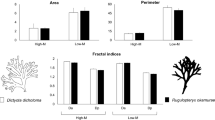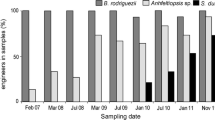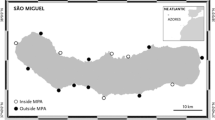Abstract
The study evaluated different macroalgal invasions in the main Mediterranean coastal habitats on hard bottom. Biodiversity, species composition and structure of macroalgal assemblages were compared among non-invaded areas and areas invaded by the Chlorophyta Caulerpa racemosa var. cylindracea and by the turf-forming Rhodophyta Womersleyella setacea in three different habitats: shallow rocky bottom, deep rocky bottom and dead matte of the seagrass Posidonia oceanica. Results showed that alien macroalgae constituted a relevant component of benthic assemblages in invaded areas of the Mediterranean Sea. Assemblages invaded by Womersleyella setacea and Caulerpa racemosa showed lower values of diversity and large differences in the structure and species composition related to non-nvaded assemblages. The species that mostly suffered from invasion were erect species reproducing sexually; moreover, the dominance of W. setacea led to low abundance of native filamentous algae, while C. racemosa colonization seemed particularly threatening for encrusting algae. All the studied habitats appeared highly invasible by alien macroalgae, even if W. setacea appeared more invasive in deeper habitats, while colonization of C. racemosa seemed more serious in shallower habitats; the dead matte of P. oceanica represented a suitable substrate for the spread of both species. Differences among assemblages in different habitats were reduced in invaded areas.




Similar content being viewed by others
References
Abrams PA (1996) Evolution and the consequences of species introductions and deletions. Ecology 77:1321–1328
Airoldi L (1998) Roles of disturbance, sediment stress and substratum retention on spatial dominance in algal turf. Ecology 79:2759–2770
Airoldi L (2000) Effects of disturbance, life-history and overgrowth on coexistence of algal crusts and turfs. Ecology 8:798–814
Airoldi L, Virgilio M (1998) Response of turf-forming algae to spatial variations in the deposition of sediments. Mar Ecol Prog Ser 165:271–282
Airoldi L, Rindi F, Cinelli F (1995) Structure, seasonal dynamics and reproductive phenology of a filamentous turf assemblage on a sediment influenced, rocky subtidal shore. Botanica Marina 38:227–237
Anderson MJ (2001) A new method for a non-parametric multivariate analysis of variance. Austral Ecol 26:32–46
Anderson MJ (2003) PCO: a FORTRAN computer program for principal coordinate analysis. Department of Statistics, University of Auckland, Auckland
Anderson MJ (2004) DISTLM v.5: a FORTRAN computer program to calculate a distance-based multivariate analysis for a linear model. Department of Statistics, University of Auckland, Auckland
Anderson MJ, Ellingsen KE, McArdle BH (2006) Multivariate dispersion as a measure of beta diversity. Ecol Lett 9:683–693
Balata D, Piazzi L, Cinelli F (2004) A comparison among macroalgal assemblages in areas invaded by Caulerpa taxifolia and C. racemosa on subtidal Mediterranean reefs. PSZNI Mar Ecol 25:1–13
Ballesteros E (2006) Mediterranean coralligenous assemblages: a synthesis of present knowledge. Oceanogr Mar Biol Annu Rev 44:123–195
Bax N, Williamson A, Aguero M, Gonzales E, Geeves W (2003) Marine invasive alien species: a threat to global biodiversity. Mar Policy 27:313–323
Boudouresque CF, Verlaque M (2002) Biological pollution in the Mediterranean Sea: invasive versus introduced macrophytes. Mar Pollut Bull 44:32–38
Britton-Simmons KH (2004) Direct and indirect effects of the introduced alga Sargassum muticum on benthic, subtidal communities of Washington State, USA. Mar Ecol Prog Ser 277:61–78
Buschbaum C, Chapman AS, Saier B (2006) How an introduced seaweed can affect epibiota diversity in different coastal systems. Mar Biol 148:743–754
Capiomont A, Breugnot E, Den Haan M, Meinesz A (2005) Phenology of a deep water population of Caulerpa racemosa in the northwestern Mediterranean Sea. Botanica Marina 48:80–83
Casas G, Scrosati R, Piriz ML (2004) The invasive kelp Undaria Pinnatifida (Phaeophyceae, Laminariales) reduces native seaweed diversity in Nuevo Gulf (Patagonia, Argentina). Biol Invasions 6:411–416
Ceccherelli G, Piazzi L, Balata D (2002) Spread of introduced Caulerpa species in macroalgal habitats. J Exp Mar Biol Ecol 280:1–11
Clarke KR (1993) Non-parametric multivariate analyses of changes in community structure. Austral Ecol 18:117–143
Clarke KR, Gorley RN (2001) PRIMER v5: user manual/tutorial. PRIMER-E, Plymouth, UK
Cohen AN, Harris LH, Bingham BL, Carlton JT, Chapman JW, Lambert CC, Lambert G, Ljubenkov JC, Murray SN, Rao LC (2005) Rapid assessment survey for exotic organisms in southern California bays and harbours, and abundance in port and non-port areas. Biol Invasions 7:995–1002
Galil BS (2000) A sea under siege – alien species in the Mediterranean. Biol Invasions 2:177–186
Gray JS (1997) Marine biodiversity: patterns, threats and conservation needs. Biodivers Conserv 6:153–175
Lodge DM (1993) Biological invasions: lesson for ecology. Trends Ecol Evol 8:133–137
MacDougall AS, Turkington R (2005) Are invasive species the drivers or passengers of change in degraded ecosystems? Ecology 86:42–55
McKinney ML, Lockwood JL (1999) Biotic homogenisation: a few winners replacing many losers in the next mass extinction. Trends Ecol Evol 14:450–453
Meinesz A, Belsher T, Thibaut T, Antolić B, Ben Mustapha K, Boudouresque CF, Chiaverini D, Cinelli F, Cottalorda JM, Djellouli A, El Abed A, Orestano C, Grau AM, Ivesa L, Jallin A, Langar H, Massuti-Pascual E, Peiraino A, Tunesi L, De Vaugelas J, Zavodnik N, Žuljević A (2001) The introduced green alga Caulerpa taxifolia continues to spread in the Mediterranean. Biol Invasions 3:201–210
Olden JD, Poff NL, Douglas MR, Douglas ME, Faush KD (2004) Ecological and evolutionary consequences of biotic homogenisation. Trends Ecol Evol 19:18–24
Piazzi L, Balata D (2007) The spread of Caulerpa racemosa var. cylindracea in the Mediterranean Sea: an example of how biological invasions can influence beta diversity. Mar Environ Res 65:50–61
Piazzi L, Ceccherelli G (2002) Effects of competition between two introduced Caulerpa. Mar Ecol Prog Ser 225:189–195
Piazzi L, Cinelli F (2001) The distribution and dominance of two introduced turf-forming macroalgae in the coast of Tuscany (Italy, northwestern Mediterranean) in relation to different habitats and sedimentation. Botanica Marina 44:509–520
Piazzi L, Cinelli F (2003) Evaluation of benthic macroalgal invasion in a harbour area of the western Mediterranean Sea. Eur J Phycol 38:223–231
Piazzi L, Balestri E, Magri M, Cinelli F (1997) Expansion de l’algue tropicale Caulerpa racemosa (Forsskål) J. Agardh (Bryopsidophyceae, Chlorophyta) le long de la côte toscane (Italie). Cryptogam Algol 18:343–350
Piazzi L, Ceccherelli G, Cinelli F (2001) Threat to macroalgal diversity: effects of the introduced green alga Caulerpa racemosa in the Mediterranean. Mar Ecol Prog Ser 210:161–165
Piazzi L, Balata D, Cecchi E, Cinelli F (2003a) Co-occurrence of Caulerpa taxifolia and C. racemosa in the Mediterranean Sea: interspecific interactions and influence on native macroalgal assemblages. Cryptogam Algol 24:233–243
Piazzi L, Ceccherelli G, Balata D, Cinelli F (2003b) Early patterns of Caulerpa racemosa recovery in the Mediterranean Sea: the influence of algal turfs. J Mar Biol Assoc UK 83:27–29
Piazzi L, Meinesz A, Verlaque M, Akçali B, Antolić B, Argyrou M, Balata D, Ballesteros E, Calvo S, Cinelli F, Cirik S, Cossu A, D’Archino R, Djellouli SA, Javel F, Lanfranco E, Mifsud C, Pala D, Panayotidis P, Peirano A, Pergent G, Petrocelli A, Ruitton S, Žuljević A, Ceccherelli G (2005) Invasion of Caulerpa racemosa var. cylindracea (Caulerpales, Chlorophyta) in the Mediterranean Sea: an assessment of the early stages of spread. Cryptogam Algol 26:189–202
Piazzi L, Balata D, Cinelli F (2007a) Invasions of alien macroalgae in Mediterranean coralligenous assemblages. Cryptogam Algol 28:289–301
Piazzi L, Balata D, Foresi L, Cristaudo C, Cinelli F (2007b) Sediment as a costituent of Mediterranean benthic communities dominated by Caulerpa racemosa var. cylindracea. Sci Mar 71:129–135
Ribera MA, Boudouresque CF (1995) Introduced marine plants, with special reference to macroalgae: mechanisms and impact. Prog Phycol Res 11:187–268
Rindi F, Guiry MD, Cinelli F (1999) Morphology and reproduction of the Mediterranean adventive rhodophyte Polysiphonia setacea Hollenberg. Hydrobiologia 398/399:91–100
Rueness J (1989) Sargassum muticum and other introduced Japanese macroalgae: biological pollution of European coasts. Mar Pollut Bull 20:173–176
Ruitton S, Javel F, Culioli JM, Meinesz A, Pergent G, Verlaque M (2005a) First assessment of the Caulerpa racemosa (Caulerpales, Chlorophyta) invasion along the French Mediterranean coast. Mar Pollut Bull 50:1061–1068
Ruitton S, Verlaque M, Boudouresque CF (2005b) Seasonal changes of the introduced Caulerpa racemosa var. cylindracea (Caulerpales, Chlorophyta) at the northwest limit of its Mediterranean range. Aquat Bot 82:55–70
Sanchez I, Fernandez C, Arrontes J (2005) Long-term changes in the structure of intertidal assemblages after invasion by Sargassum muticum (Phaeophyta). J Phycol 41:942–949
Scheibling RE, Gagnon P (2006) Competitive interactions between the invasive green alga Codium fragile ssp. tomentosoides and native canopy-forming seaweeds in Nova Scotia (Canada). Mar Ecol Prog Ser 325:1–14
Smart SM, Thompson K, Marris RH, Le Duc MG, Maskell LC, Firbank LG (2006) Biotic homogenization and changes in species diversity across human-modified ecosystems. Proc R Soc Lond B 273:2659–2665
Stachowicz JJ, Whitlatch RB, Osman RW (1999) Species diversity and invasion resistance in a marine ecosystem. Science 286:1577–1579
Staehr PA, Pedersen MF, Thomsen MS, Wernberg T, Krause-Jensen D (2000) Invasion of Sargassum muticum in Limfjorden (Denmark) and its possible impact on the indigenous macroalgal community. Mar Ecol Prog Ser 207:79–88
Underwood AJ (1992) Beyond BACI: the detection of environmental impacts on populations in the real, but variable, world. J Exp Mar Biol Ecol 161:145–178
Underwood AJ (1997) Experiments in ecology. Their logical design and interpretation using analysis of variance. Cambridge University Press, Cambridge
Verlaque M (1994) Inventaire des plantes introduites en Méditerranée: origines et répercussions sur l’environnement et les activités humaines. Oceanol Acta 17:1–23
Verlaque M, Fritayre P (1994) Modifications des communautés algales méditerranéennes en présence de l’algue envahissante Caulerpa taxifolia (Vahl) C. Agardh. Oceanol Acta 17:659–672
Verlaque M, Durand C, Huisman JM, Boudouresque CF, le Parco Y (2003) On the identity and origin of the Mediterranean invasive Caulerpa racemosa (Caulerpales, Chlorophyta). Eur J Phycol 38:325–329
Viejo RM (1997) The effects of colonization by Sargassum muticum on tidepool macroalgal assemblages. J Mar Biol Assoc UK 77:325–340
Walker DI, Kendrick GA (1998) Threats to macroalgal diversity: marine habitat destruction and fragmentation, pollution and introduced species. Botanica Marina 41:105–112
Wasson K, Fenn K, Pearse JS (2005) Habitat differences in marine invasions of central California. Biol Invasions 7:935–948
Wikstrom SA, Kautsky L (2004) Invasion of a habitat-forming seaweed: effects on associated biota. Biol Invasions 6:141–150
Winer BJ, Brown DR, Michelis KM (1991) Statistical principles in experimental design. McGraw-Hill, New York
Acknowledgment
We wish to thank I. Bertocci for his helpful comments on the manuscript.
Author information
Authors and Affiliations
Corresponding author
Rights and permissions
About this article
Cite this article
Piazzi, L., Balata, D. Invasion of alien macroalgae in different Mediterranean habitats. Biol Invasions 11, 193–204 (2009). https://doi.org/10.1007/s10530-008-9224-3
Received:
Accepted:
Published:
Issue Date:
DOI: https://doi.org/10.1007/s10530-008-9224-3




